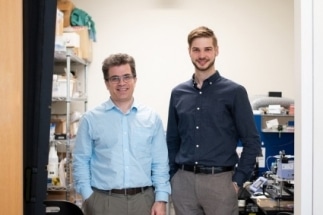Mar 25 2019
A majority of the people are unaware that diagnostic imaging and music have something in common. The lower or higher pitches of the sounds are dependent on the size of the object that makes them.
 Dr Michael Kolios (left) and Dr Michael Moore (right). (Image credit: Ryerson University)
Dr Michael Kolios (left) and Dr Michael Moore (right). (Image credit: Ryerson University)
Double basses and tubas are huge and create deep low-pitch sounds, whereas small instruments like violins and flutes create high-pitched sounds. The captivating fact is that the same effect takes place when sound is emitted by biological structures such as tissues or cells—the pitch differs based on the size.
However, what types of sounds do biological structures produce? Furthermore, how can these sounds be listened to?
Making the most of the correlation between pitch and size, recently, a Ryerson-led research group working from the Institute for Biomedical Engineering, Science & Technology (iBEST) at St. Michael’s Hospital devised a mode of imaging so innovative that their research outcomes were reported in the Nature journal Communications Physics.
A recognition of this advancement starts with the basics of Photoacoustic (PA) imaging, a technology that is rapidly gaining attention in biomedical research. Similar to its kin Ultrasound (US) imaging, PA imaging produces a visual image of biological structures by gathering sound waves.
In contrast to US imaging technology that involves sending soundwaves into a biological structure and paying attention to the echoes when they bounce around, PA imaging involves something completely different.
With photoacoustic imaging, we project light into structures that will absorb it, such as blood vessels. Light waves cause biological structures to heat up by a tiny fraction, which triggers an almost imperceptible expansion in volume. When that happens, sound is generated, like thunder after a lightning strike.
Dr Michael Kolios, Professor, Ryerson University.
Kolios is the PA imaging pioneer who supervised the research.
A majority of the prevalent PA imaging methods involve measuring amplitude (loudness), exhibiting areas that emit louder sounds with brighter pixels. The Ryerson-led researchers intended to devise a method with the ability to measure the frequency (pitch) of sounds emitted from biological structures.
Depending on the size of a biological structure, the pitch of the sound waves it emits will be higher or lower. If we could filter incoming sounds by frequency, we could create images that focus on structures of a particular size, which would help to reveal features that might otherwise be hidden or less prominent.
Dr Michael Moore, Medical Physics Resident, Grand River Hospital, Kitchener.
Moore headed the research group as a doctoral student under the supervision of Kolios.
The researchers devised a method called F-Mode (for frequency), which allowed them to subdivide PA signals into different frequency bands. Then, they were successful in demonstrating selective improvement of features of different sizes in samples such as biological cells and live zebrafish larvae—all without using contrast dyes that would usually be needed for other sophisticated imaging techniques.
Moore and Kolios quickly indicate that vital to their success was the chance to work at iBEST and with Dr Xiao-Yan Wen and his team at Zebrafish Centre for Advanced Drug Discovery. “Without the knowledge and expertise of the team at the Wen Lab, it would not have been possible to demonstrate that our technique works,” stated Moore.
The research group, including Ryerson Biomedical Physics doctoral candidates Eno Hysi and Muhannad Fadhel, now intends to translate F-Mode into clinical applications, where it will offer huge advantages. For instance, the capability to segment and improve features of different scales has considerable potential in areas like neurosurgery, ophthalmology, and the detection of different conditions such as hypertension.